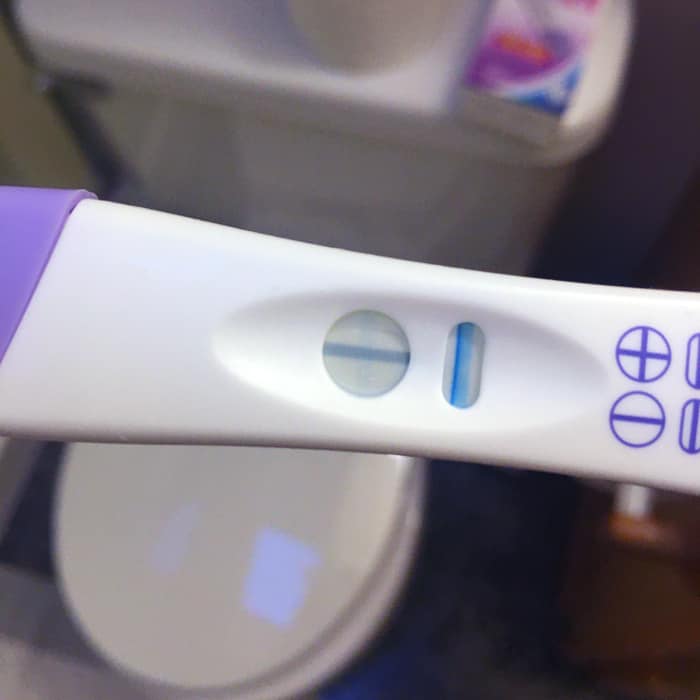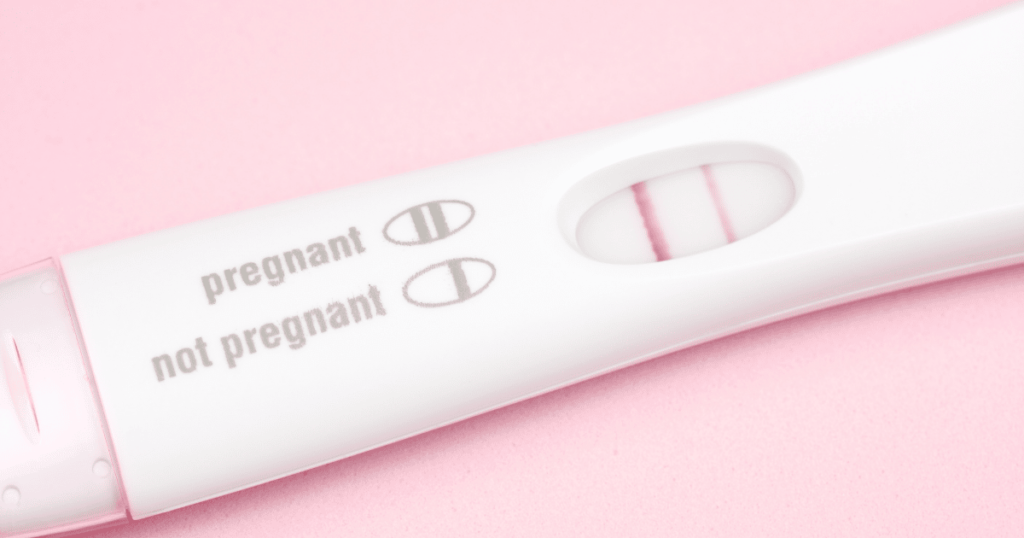Taking a home pregnancy test can be an exciting, nerve-wracking experience. It’s important to understand how the test works and how to properly interpret the results. One common issue that can cause confusion is the appearance of an evaporation line on a First Response pregnancy test.
An evaporation line is a colorless streak that can appear on a pregnancy test after the reaction time has passed. This can happen if the test is left sitting for too long or if it gets wet. Evaporation lines can be mistaken for a positive result, leading to confusion and disappointment.
To avoid this issue, it’s important to follow the instructions on the First Response pregnancy test carefully. The test should be taken first thing in the morning, when the concentration of the pregnancy hormone hCG is highest in the urine. After collecting the urine sample, the test should be held in the stream of urine for 5-10 seconds or dipped into a cup of urine for the recommended amount of time.
After waiting the suggested amount of time (usually 3-5 minutes), the test should be read immediately. Any result that appears after the recommended time is considered invalid and may be an evaporation line. It’s important to read the test in good lighting and to hold it up to the instructions to ensure accurate interpretation.
If an evaporation line appears, it can be tempting to interpret it as a positive result. However, it’s important to remember that evaporation lines are not true positive results and should not be used to confirm a pregnancy. If there is any doubt about the result, it’s best to retake the test or consult with a healthcare provider.
Evaporation lines can appear on First Response pregnancy tests and can cause confusion. Following the instructions carefully, reading the test within the recommended time frame, and usig good lighting can help avoid this issue. If an evaporation line appears, it should not be interpreted as a positive result and further testing or consultation with a healthcare provider may be necessary.
Do Evaporation Lines Appear on All First Response Tests?
Not all First Response pregnancy tests have evaporation lines. Evaporation lines are a result of the chemical reaction between a woman’s urine and the chemicals on the test strip. While it’s possible for an evaporation line to appear on any pregnancy test, not all women will experience them. However, it’s important to note that evaporation lines can sometimes be confused with faint positive lines, so it’s always best to read the test within the recommended reaction time and to follow the instructions carefully. If you are unsure about your test results, it’s recommended to consult with your healthcare provider.

Does First Response Show Pink EVAP Lines?
EVAP lines on a First Response pregnancy test are colorless and not pink in color. An EVAP line is a faint streak that appears on the test strip after the suggested time frame for reading the results has passed. It is not a true positive result and does not indicate pregnancy. It is essential to read the results within the recommended time frame mentioned in the instructions to avoid confusion between an EVAP line and a positive result. It is always best to confirm any positive results with a healthcare professional.
Time Required for Evaporation Line to Appear
An evaporation line on a pregnancy test may appear ater the designated testing time frame, which is usually around two to ten minutes. However, it’s important to note that an evaporation line is not a true positive result and is rather a result of urine drying on the test strip. This can happen if the test is left out for too long or if there is not enough urine on the test strip. It’s important to read the test results within the designated time frame to avoid confusion and to ensure accurate results. If you suspect you may be pregnant, it’s recommended to follow up with a healthcare provider for confirmation.
Can Positive Results Be Obtained From Evaporation Lines?
Evaporation lines can appear on a pregnancy test and be mistaken for a positive result, but they are not actually a positive indication of pregnancy. Evaporation lines occur when urine on the test strip dries up ater the recommended time frame for reading the result. These lines can appear as faint, colorless lines or as slightly colored lines that may resemble a positive result. It’s important to note that evaporation lines are considered false-positives and should not be interpreted as a confirmed pregnancy. To avoid confusion, it’s best to read the result within the recommended time frame and not rely on it after that window has passed.
The Color of a First Response Evaporation Line
The color of a First Response evaporation line is typically colorless or grayish, which can sometimes be mistaken for a faint positive line. It’s important to note that an evaporation line is not an indication of pregnancy and can appear if a person waits for longer than the suggested time to read the test result. Therefore, it’s recommended to read the test result within the designated time frame to avoid confusion or misinterpretation of the results.

Thickness of EVAP Lines
Evaporation lines, also known as evap lines, are typically thin and colorless or may appear as a faint water spot. These lines can appear in the same location as the pregnancy test line, usually to the right of the control line. It’s important to note that evaporation lines can sometimes be mistaken for a positive pregnancy test result, but they are not a reliable indicator of pregnancy. If you are unsure about the results of your test, it’s recommended to consult with a healthcare professional.
Can a Pregnancy Test Show Positive Results After an Extended Period of Time?
Pregnancy tests are designed to be read within a certain amount of time after taking the test. If a pregnancy test is left sitting for too long, it may show a false positive result. This is because the test works by detecting the hormone human chorionic gonadotropin (HCG) in your urine. HCG is produced by the placenta after a fertilized egg implants in the uterus. However, if a test is left sitting for too long, the urine on the test strip may evaporate, causing the result to become distorted. This can lead to a false positive result, indicating that you are pregnant when you are actualy not. It is important to follow the instructions on the pregnancy test and read the result within the recommended time frame to ensure accurate results.
Does the Darkness of an Evaporation Line Increase?
An evaporation line on a pregnancy test is a faint, colorless line that may appear afer the designated reaction time of the test. It is not a positive result, but rather a reaction between the urine and the test strip. An evaporation line typically does not get darker over time. In fact, it may fade or disappear entirely as the test dries out. It is important to read the test within the designated time frame and not to rely on any changes that may occur after that time. If you are unsure about the result, it is best to take another test or consult with a healthcare provider.
Do EVAP Lines Appear on Pink Dye Tests?
Pink dye tests can sometimes leave evaporation lines, but it’s less common than with blue dye tests. An evaporation line is a faint, colorless line that appears on the test afer the allotted time for reading the results has passed. Evaporation lines can be confusing and misleading, as they can sometimes resemble a positive result. However, it’s important to note that evaporation lines do not indicate pregnancy and should not be considered a reliable result. To avoid confusion, it’s recommended to read the test within the recommended time frame and to follow the manufacturer’s instructions carefully. Additionally, it’s always a good idea to confirm any positive result with a healthcare provider.

Identifying an EVAP Line
To determine if a line on a pregnancy test is an evaporation line or a positive result, it is important to consider the timing of the test and the color and thickness of the line. An evaporation line typically appears after the test has dried, which is usually after the allotted time frame for reading the test has passed. These lines are often colorless or have a faint gray or light pink hue, and they may appear thinner or more indistinct than a true positive line. It is important to note that evaporation lines are not indicative of pregnancy and should not be relied upon as a positive result. If there is any doubt abot the results of a pregnancy test, it is recommended to take another test or consult with a healthcare provider.
Conclusion
An evaporation line on a First Response pregnancy test may occur if the test is read after the suggested reaction time. Evaporation lines are colorless streaks that appear when urine dries on the test strip and are not to be confused with a true positive result. To avoid confusion, it is essential to read the results within the recommended time frame of two to ten minutes. It is also essential to follow the instructions carefully and ensure that the test is not exposed to moisture. While evaporation lines can cause false-positive results, they are not a common occurrence and should not be a cause for concern if the test is read correctly. First Response pregnancy tests are reliable and accurate when used correctly.
